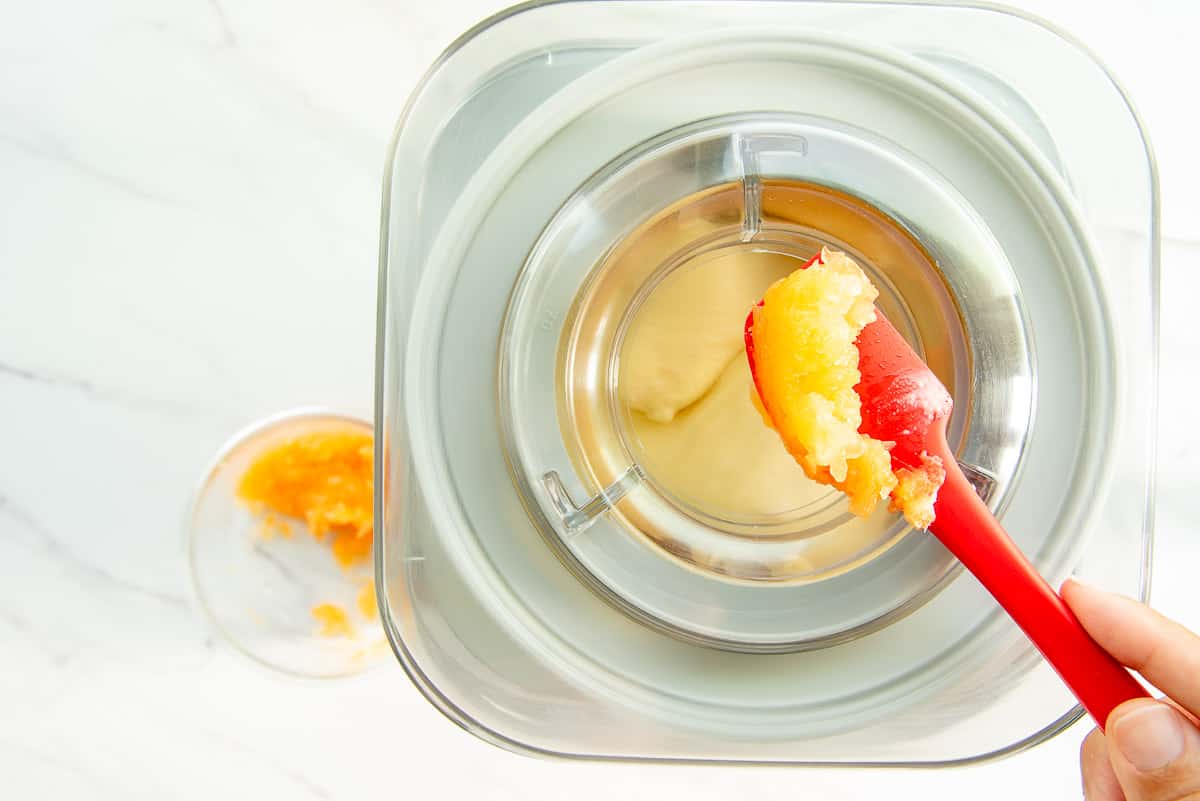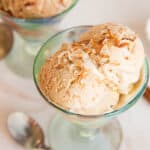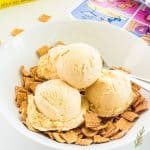Cantaloupe Frozen Custard is a dessert of fresh cantaloupe melon shredded and churned in a rich egg and dairy custard base. If you’re a cantaloupe lover, this recipe is the perfect addition to your menu, especially during the hot summer months.
What Is Cantaloupe Frozen Custard?
Cantaloupe frozen custard is a dessert made from a thick custard churned with shreds of ripe, macerated cantaloupe melon. I developed this recipe in the 90s while working at an ice cream shop in Towson, Maryland. A farmer’s market was held every Thursday during the warmer months, so I’d pal up with a vendor and buy their unsold fruits. What began as cantaloupe ice cream became a frozen custard because I like decadence.
Cantaloupes are actually muskmelons, which are sweet and have a yellow-tan weblike rind when they’re ripe. The sweet orange-fleshed melon is in season during the summer when its floral aroma and moist interiors are at their best tasting. The main flavor in this recipe is that of cantaloupe with subtle notes of vanilla and ginger.
What Makes It Different From Cantaloupe Ice Cream?
The main difference between cantaloupe frozen custard and cantaloupe ice cream is the addition of eggs in the dairy base. Frozen custard is a milk and cream base that’s heated and thickened with eggs. Cantaloupe ice cream is usually just hot milk and cream with sugar.
Adding eggs to the custard makes the finished dessert smoother and creamier, with fewer calories than ice cream.
What Do I Need To Make Cantaloupe Frozen Custard?
The ingredients in cantaloupe frozen custard are fresh, ripe cantaloupe, whole milk, heavy cream, egg yolks, granulated sugar, ground ginger, kosher salt, and vanilla extract.
An electric hand mixer or an immersion blender makes whipping the eggs easier. Of course, you’ll also need an ice cream maker to churn the custard.
How Do I Pick The Perfect Cantaloupe?
To pick the perfect cantaloupe, look for a melon that is tan in appearance and emits a musky, sweet smell when you sniff its flower end (or belly button). Avoid cantaloupes with green rinds, those that are very firm, and melons with brown or mushy spots when you press them.
You can also make this recipe with pre-cut cantaloupe from the produce section. Just grate it in your food processor with the grater blade.
What’s The Best Way To Prepare Fruit For Freezing?
When you add water to frozen custard or ice cream, you’re creating ice crystals in the mixture. Ice crystals make ice cream and frozen custard gritty and lead to freezer burn.
It’s best to macerate any fruits you plan to add to frozen custard or ice cream. Macerating is a technique that draws out the fruit’s natural juices, which you can later use to add more flavor to the frozen custard or ice cream.
First, use a large knife to remove the rind from the cantaloupe. Cut the melon in half and use a wide spoon to scrape out the white seeds and stringy insides of the melon. You can discard the seeds or plant them for next year’s custard!
Cut the fruit into 2-inch wide slices, then use a box grater to grate the melon into a medium bowl. Add sugar to the shredded melon in the bowl and stir to combine. Allow the fruit to macerate for at least 30 minutes. You can leave it on the countertop or cover the bowl and refrigerate it during this time.
How Far Ahead Can I Macerate The Shredded Cantaloupe?
Macerate your fruit for at least 30 minutes for the most flavorful results, though overnight is best. The longer the fruit macerates, the more juice you’ll extract from it and the more concentrated the flavor will be.
Strain the fruit from its juice by scooping half from the bowl and into a kitchen towel (or cheesecloth) placed inside a colander or fine-mesh sieve. Allow the juice to drain naturally for 1 to 2 minutes, then gather the ends of the kitchen towel to twist it and squeeze out the remaining juice. Squeeze out the juice from the remaining cantaloupe in the bowl until you have bone-dry shreds of melon. Add these melon shreds to a small bowl and cover it. Store the shredded cantaloupe in the fridge until you churn the frozen custard.
Add the strained cantaloupe juice to a 2-quart pot and bring it to a simmer over medium heat. Simmer the juice until it has reduced by half. Remove the pot from the stove once you have a cantaloupe syrup. Pour the syrup into a separate bowl and allow it to cool while you prepare the custard base.
Why Do I Need To Temper The Egg Yolks?
Add the whole milk, heavy cream, and kosher salt to the pot you used to reduce the cantaloupe juice. Bring this mixture up to steaming, stirring occasionally, over medium heat.
In a large bowl, whip the egg yolks and sugar together at medium speed using the whip attachment of an electric hand mixer or immersion blender. Whip the egg-sugar mixture for 3 minutes or until pale yellow and thick.
Once the milk mixture in the pot begins to steam, reduce the heat to medium-low. Use a ladle to scoop up a cup of the hot mixture. Trickle the hot liquid into the whipped egg mixture, stirring constantly with the whisk to temper the eggs. Return the tempered egg mixture to the pot in the same manner. Whisk constantly to avoid curdling the custard.
Tempering eggs acclimates them to the hot liquid, preventing the mixture from curdling later. If you were to dump the egg mixture into the hot milk, you’d have sweet scrambled eggs instead of a frozen custard base.
How Far Ahead Can I Make The Frozen Custard Base?
Continue cooking the milk mixture, stirring constantly, for 3 to 4 minutes or until the mixture coats the back of a rubber spatula or spoon.
Use the whisk to stir the vanilla extract and cantaloupe syrup you made earlier into the custard. Transfer the cantaloupe custard to a bowl and allow it to cool to room temperature. Once it’s cool, cover the container with a lid or plastic wrap and refrigerate the mixture for 12 hours or overnight to age it.
Aging a frozen custard base allows the proteins in the mixture to plump up and bind with the water. This creates a fuller, creamier mouthfeel after churning the cantaloupe frozen custard. I recommend making the cantaloupe frozen custard at least 12 hours ahead to age it. After chilling the custard base for 4 hours, you can proceed with the recipe, but the results won’t be as remarkable.
How Long Does It Take To Churn Frozen Custard?
Just before churning the cantaloupe frozen custard base, stir it well. Pour the base into the frozen bowl of an ice cream maker and set the machine to “Ice Cream” if it has that setting. Churn the cantaloupe frozen custard for 10 minutes.
Add the shredded cantaloupe in small amounts (about a tablespoon) to the machine as it churns once the custard is slightly frozen. After you add all of the shredded cantaloupe, continue churning the custard until it is the consistency of soft serve ice cream or about 20 minutes.
What’s The Best Way To Store It?
Scrape the cantaloupe frozen custard into two 1-quart ice cream containers once it’s the consistency of soft serve ice cream. This recipe makes 1 1/4 quarts of cantaloupe frozen custard, so you won’t fill both containers. Cover the containers and freeze the custard upside-down for at least 4 hours.
Freezing the custard after churning allows it to set up properly. Not doing so will result in you scooping up cantaloupe frozen goo. Freezing frozen custards upside down in containers prevents ice crystals from forming on their surface, which causes freezer burn. It also inhibits melted frozen custard from dripping onto the remaining cantaloupe frozen custard in the container, causing an ice crust.
How Do I Serve Cantaloupe Frozen Custard?
Scoop the frozen custard with an ice cream scoop dipped in warm water and shaken dry. Ensure you return your containers of frozen custard to the freezer right after you scoop what you plan to eat.
The best way to serve cantaloupe frozen custard is on its own, so you can enjoy its deep flavor. You can also serve it a la mode style, scooped on top of slices of pound cakes, pies, or sandwiched between cookies.
How Long Will It Keep In The Freezer?
You can store cantaloupe frozen custard in the freezer for six weeks. Always return your containers of frozen custard to the freezer soon after scooping from them to prevent melting and the formation of ice crystals. Always store your ice cream containers upside down in the freezer, too.
If your cantaloupe frozen custard smells off, has a grainy consistency, or has large chunks of ice crystals on its surface, it has spoiled and should be discarded.
Cantaloupe frozen custard is a delicious, unique way to put those summer melons to use. You will adore its sweet, floral flavor, whether you serve it alone or with your favorite pies or cakes. This cantaloupe frozen custard will impress your guests, so make a double batch to share. Don’t forget to let me know what you think of the recipe in the comments below. Pin this recipe to your frozen desserts board and tag me in your pictures when you make it, too!

Cantaloupe Frozen Custard
at Sense & EdibilityEquipment
- box grater
- saucier or pot with sloped sides
- electric hand mixer with whisk attachment
- ice cream machine
- 2 1-quart ice cream containers
Ingredients
- 4 pound (1.8 kilogram) cantaloupe melon
- 1 1/2 cups (355 milliliters) whole milk
- 1 cup (240 milliliters) heavy cream
- 1/4 teaspoon kosher salt optional
- 3/4 cup (150 grams) granulated sugar separated
- 6 large egg yolks
- 1/2 teaspoon ground ginger optional
- 1 1/2 teaspoons (7 milliliters) vanilla extract
Instructions
Shred, Then Macerate the Cantaloupe
- Use a large knife to remove the rind from the cantaloupe. Cut the melon in half and use a wide spoon to scrape out the white seeds and stringy insides of the melon.
- Cut the fruit into 2-inch wide slices, then use a box grater to grate the melon into a medium bowl. Add 1/2 cup (100 grams) of sugar to the shredded melon in the bowl and stir to combine.
- Allow the fruit to macerate for at least 30 minutes, but preferably up to 12 hours. You can leave it on the countertop or cover the bowl and refrigerate it during this time.
Strain the Cantaloupe To Make a Syrup
- Strain the fruit from its juice by scooping half from the bowl and into a kitchen towel (or cheesecloth) placed inside a colander or fine-mesh sieve. Allow the juice to drain naturally for 1 to 2 minutes, then gather the ends of the kitchen towel to twist it and squeeze out the remaining juice. Squeeze out the juice from the remaining cantaloupe in the bowl until you have bone-dry shreds of melon.
- Add these melon shreds to a small bowl and cover it. Store the shredded cantaloupe in the fridge until you churn the frozen custard. Add the strained cantaloupe juice to a 2-quart pot and bring it to a simmer over medium heat. Simmer the juice until it has reduced by half.
- Remove the pot from the stove once you have a cantaloupe syrup. Pour the syrup into a separate bowl and allow it to cool while you prepare the custard base.
Make the Frozen Custard Base
- Add the whole milk, heavy cream, and kosher salt to the pot you used to reduce the cantaloupe juice. Bring this mixture up to steaming, stirring occasionally, over medium heat.
- In a large bowl, whip the egg yolks, the remaining sugar, and the ground ginger together at medium speed using the whip attachment of an electric hand mixer or immersion blender. Whip the egg-sugar mixture for 3 minutes or until pale yellow and thick.
- Once the milk mixture in the pot begins to steam, reduce the heat to medium-low. Use a ladle to scoop up a cup of the hot mixture. Trickle the hot liquid into the whipped egg mixture, stirring constantly with the whisk to temper the eggs. Return the tempered egg mixture to the pot in the same manner. Whisk constantly to avoid curdling the custard.
- Continue cooking the milk mixture, stirring constantly, for 3 to 4 minutes or until the mixture coats the back of a rubber spatula or spoon. Use the whisk to stir the vanilla extract and cantaloupe syrup you made earlier into the custard.
Age, Then Churn the Cantaloupe Frozen Custard
- Transfer the cantaloupe custard to a bowl and allow it to cool to room temperature. Once it's cool, cover the container with a lid or plastic wrap and refrigerate the mixture for 12 hours or overnight to age it.
- Just before churning the cantaloupe frozen custard base, stir it well. Pour the base into the frozen bowl of an ice cream maker and set the machine to "Ice Cream" if it has that setting. Churn the cantaloupe frozen custard for 10 minutes.
- Add the shredded cantaloupe in small amounts (about a tablespoon) to the machine as it churns once the custard is slightly frozen. Once all of the shredded cantaloupe has been added, continue churning the custard until it is the consistency of soft serve ice cream or about 20 minutes.
Freeze the Churned Cantaloupe Frozen Custard
- Scrape the cantaloupe frozen custard into two 1-quart ice cream containers once it's the consistency of soft serve ice cream. Cover the containers and freeze the custard upside-down for at least 4 hours.
- Scoop the frozen custard with an ice cream scoop dipped in warm water and shaken dry. Ensure you return your containers of frozen custard to the freezer right after you scoop what you plan to eat.Serve cantaloupe frozen custard is on its own, scooped on top of slices of pound cakes, pies, or sandwiched between cookies.
Notes
Swaps and Substitutions:
- Swap the cantaloupe with honeydew or a similar melon. Avoid watermelon, which contains too much water.
- Replace the heavy cream with more whole milk for a lighter custard.
- Omit the ground ginger.
- Replace the ground ginger with ground cinnamon.
- Use pre-cut cantaloupe from the produce section and grate it in your food processor with the grater blade.
Tips and Techniques:
- To pick the perfect cantaloupe, look for a melon that is tan in appearance and emits a musky, sweet smell when you sniff its flower end (or belly button).
- Avoid cantaloupes with green rinds, those that are very firm, and melons with brown or mushy spots when you press them.
- Macerating is a technique that draws out the fruit's natural juices, which you can later use to add more flavor to the frozen custard or ice cream.
- Macerate your fruit for at least 30 minutes for the most flavorful results, though overnight is best. The longer the fruit macerates, the more juice you'll extract from it and the more concentrated the flavor will be.
- Tempering eggs acclimates them to the hot liquid, preventing the mixture from curdling later.
- You can churn the custard base after chilling it in an ice bath for 4 hours, but the results won't be as remarkable as when its aged overnight.
- This recipe makes 1 1/4 quarts of cantaloupe frozen custard, so you won't fill both containers.
- Freezing the custard after churning allows it to set up properly so you don't end up with frozen goo.
Storage Instructions:
- Store cantaloupe frozen custard in the freezer for six weeks.
- Return the containers of frozen custard to the freezer immediately after scooping from them to prevent melting and the formation of ice crystals.
- Remember to store your ice cream containers upside down in the freezer, which prevents ice crystals from forming on the surface causing freezer burn.
- Cantaloupe frozen custard that smells off, has a grainy consistency, or has large chunks of ice crystals on its surface has spoiled and should be discarded.

















My husband loves cantaloupe and ice cream so I was eager to make this for him as a surprise. He said it was one of the best fruit based ice creams he ever had. Also thanks for the tips – I learned a few new techniques I will carry into my next recipe !
I’m so glad to know you and hubby enjoyed it, Geo!
So cantaloupe is my least favorite fruit however when I had it like this it changed my mind. This custard was amazing.
Same. I was never a fan until this recipe.
I’ve always loved the refreshing taste of cantaloupe, and incorporating it into a frozen custard is a brilliant idea. The creamy texture of the custard combined with the natural sweetness of the cantaloupe sounds was a match made in dessert heaven!
I’m so glad you like it as much as we do, Sophie!
This custard was so refreshing and hit the spot! We love cantaloupe and it was perfect. Can’t wait to make more over summer 🙂 thansk!
My pleasure! So glad you enjoyed it!
A simple and refreshing summer treat! I always struggle with what to do with cantaloupe. Love the idea of making it into a custard. Thanks for the recipe!
I’m so glad you liked it!
I love anything cantaloupe and I am SAVING this recipe to make again and again with our amazing local cantaloupes are in season. Thank you!
Local produce is always the best choice, Bernice.